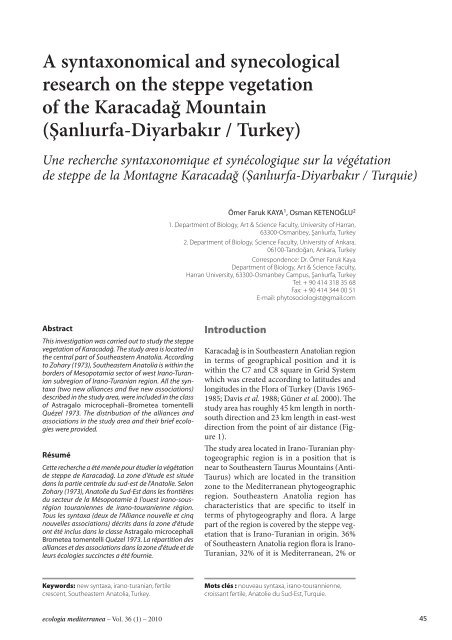Revue internationale d'écologie méditerranéenne International ...
Revue internationale d'écologie méditerranéenne International ...
Revue internationale d'écologie méditerranéenne International ...
You also want an ePaper? Increase the reach of your titles
YUMPU automatically turns print PDFs into web optimized ePapers that Google loves.
A syntaxonomical and synecological<br />
research on the steppe vegetation<br />
of the Karacadağ Mountain<br />
(Şanlıurfa-Diyarbakır / Turkey)<br />
Une recherche syntaxonomique et synécologique sur la végétation<br />
de steppe de la Montagne Karacadağ (Şanlıurfa-Diyarbakır / Turquie)<br />
Abstract<br />
This investigation was carried out to study the steppe<br />
vegetation of Karacadağ. The study area is located in<br />
the central part of Southeastern Anatolia. According<br />
to Zohary (1973), Southeastern Anatolia is within the<br />
borders of Mesopotamia sector of west Irano-Turanian<br />
subregion of Irano-Turanian region. All the syntaxa<br />
(two new alliances and five new associations)<br />
described in the study area, were included in the class<br />
of Astragalo microcephali–Brometea tomentelli<br />
Quézel 1973. The distribution of the alliances and<br />
associations in the study area and their brief ecologies<br />
were provided.<br />
Résumé<br />
Cette recherche a été menée pour étudier la végétation<br />
de steppe de Karacadağ. La zone d'étude est située<br />
dans la partie centrale du sud-est de l'Anatolie. Selon<br />
Zohary (1973), Anatolie du Sud-Est dans les frontières<br />
du secteur de la Mésopotamie à l'ouest irano-sousrégion<br />
touraniennes de irano-touranienne région.<br />
Tous les syntaxa (deux de l'Alliance nouvelle et cinq<br />
nouvelles associations) décrits dans la zone d'étude<br />
ont été inclus dans la classe Astragalo microcephali<br />
Brometea tomentelli Quézel 1973. La répartition des<br />
alliances et des associations dans la zone d'étude et de<br />
leurs écologies succinctes a été fournie.<br />
Keywords: new syntaxa, irano-turanian, fertile<br />
crescent, Southeastern Anatolia, Turkey.<br />
ecologia mediterranea – Vol. 36 (1) – 2010<br />
Ömer Faruk KAYA 1 , Osman KETENOĞLU 2<br />
1. Department of Biology, Art & Science Faculty, University of Harran,<br />
63300-Osmanbey, Şanlıurfa, Turkey<br />
2. Department of Biology, Science Faculty, University of Ankara,<br />
06100-Tandoğan, Ankara, Turkey<br />
Correspondence: Dr. Ömer Faruk Kaya<br />
Department of Biology, Art & Science Faculty,<br />
Harran University, 63300-Osmanbey Campus, Şanlıurfa, Turkey<br />
Tel: + 90 414 318 35 68<br />
Fax: + 90 414 344 00 51<br />
E-mail: phytosociologist@gmail.com<br />
Introduction<br />
Karacadağ is in Southeastern Anatolian region<br />
in terms of geographical position and it is<br />
within the C7 and C8 square in Grid System<br />
which was created according to latitudes and<br />
longitudes in the Flora of Turkey (Davis 1965-<br />
1985; Davis et al. 1988; Güner et al. 2000). e<br />
study area has roughly 45 km length in northsouth<br />
direction and 23 km length in east-west<br />
direction from the point of air distance (Figure<br />
1).<br />
e study area located in Irano-Turanian phytogeographic<br />
region is in a position that is<br />
near to Southeastern Taurus Mountains (Anti-<br />
Taurus) which are located in the transition<br />
zone to the Mediterranean phytogeographic<br />
region. Southeastern Anatolia region has<br />
characteristics that are specific to itself in<br />
terms of phytogeography and flora. A large<br />
part of the region is covered by the steppe vegetation<br />
that is Irano-Turanian in origin. 36%<br />
of Southeastern Anatolia region flora is Irano-<br />
Turanian, 32% of it is Mediterranean, 2% or<br />
Mots clés : nouveau syntaxa, irano-tourannienne,<br />
croissant fertile, Anatolie du Sud-Est, Turquie.<br />
45
















